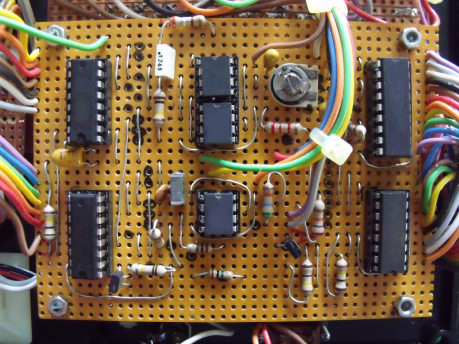CHAPTER 2
Zooming into Electronics: Electronic Building Blocks |  |
THIS CHAPTER WILL HELP YOU TO THINK like an inventor and an electronics design engineer. You will learn that electronic devices are made up of a number of different building blocks that interact with each other to create a finished product. You’ll explore how electronic devices can be designed using various electronic building blocks, which sets the scene for the experiments in later chapters.
Think Like an Inventor
Every electronic device is created by design, using a number of individual electronic components that are linked together to produce an electronic circuit. The number of electronic components that are used to make up an electronic circuit will vary, depending on how complex the device is. Usually, the more complex the device, the more electronic components are required. You will be reading about electronic components in more detail in Chapter 3.
Lots of the fun of experimenting with electronics comes from imagining what you want to create, and then figuring out what you need to do to create it. Before you select any electronic components, though, you need to start thinking like an inventor and an electronics design engineer. A good inventor or designer begins with a few preliminary steps to get her ready to build a creation. There are three main stages in the process:
1. Create a design specification.
2. List the building blocks.
3. Design and test the electrical circuit.
Write the Design Specification
Let’s consider, for example, an inventor who wants to design and build a telephone. The inventor will start by writing down a list of things that she imagines the telephone will do. These features are also known as specifications. For a telephone, the main specifications might look like these:
• The device will enable two people at some distance away from each other to carry on a conversation.
• Each person will be able to talk into the telephone via some device.
• Each person will be able to hear the other person’s voice via some device.
• Each telephone will be connected to another telephone via a cable.
• The audio signals from each telephone will be transmitted across a cable.
• Each telephone will be assigned a number that must be typed in by a caller to call that telephone.
• Each telephone must include some sort of device for indicating the number of the person to be called.
• Each person’s phone will ring when another person is calling.
List the Electronic Building Blocks
Once the design specification has been listed, the inventor can then list the building blocks that are needed to create each of the specifications for the telephone. These might include the following:
• Earpiece This will allow one person to hear the other person talking.
• Microphone This will enable one person to talk to the other person.
• Numeric keypad This allows the caller to punch in the other person’s telephone number to make the receiver’s phone “ring.”
• Display This allows the caller to see the number he has typed into the keypad.
• Ringer This audible device will be positioned inside the telephone to make a noise to let the receiver know that someone is calling him and wants to talk.
Design and Test the Electronic Circuit
After the inventor has identified each of the building blocks required to make the telephone, she can use her knowledge of electronics and electronic components to begin designing individual electronic circuits that will perform the requirements of each building block. Each of these individual circuits will then be combined to produce one complete electronic circuit to create the functions of a working telephone. The inventor will then spend some time building and testing the final electronic circuit to make sure that it performs as she expects.
If the design process has been successful, the inventor will have created a working telephone that meets her original design specification. You can see from this simple example that a number of design stages are involved before an inventor actually picks up any electronic components and starts building.
Zooming into Electronics
Now imagine that you have the inventor’s finished telephone in front of you, and you want to understand how it works. To do this, you’ll use something called “reverse engineering,” which means you will examine the creation to try to retrace the steps of the original inventor. You might imagine, for example, that you have a special microscope that allows you to examine the telephone on three different levels. The “special microscope” that allows you to do all this is your mind. As you become more experienced in understanding how electronic building blocks and circuits can be made, you will be able to construct (and deconstruct) electronic circuits more easily.
1X Magnification
At the first level, you’ll look at the electronic device with your naked eye. You can see the electronic device, understand what it does, and see its basic features.
2X Magnification
At the second level, you are looking inside the telephone, where you can identify the individual building blocks that make up the telephone. For example, you can see that the telephone has a keypad that lets you type in your friend’s telephone number, and it has a screen that allows you to see the telephone number that you have typed into the phone.
3X Magnification
Finally, this magnification level allows you to zoom even further into each building block to identify and examine the individual electronic circuits and components that make up each of the individual building blocks. You’ll read more about components in Chapter 3.
Electronic Building Blocks
Now that you have learned that electronic circuits can be made up of building blocks, you might be wondering what these building blocks are. Take a look at the diagram in Figure 2-1, which shows four main electronic building blocks that can be used to make up any electronic circuit: power supply, input, output, and control circuitry.
These building blocks could be an individual electronic component, or they could be a number of electronic components linked together to form an electronic circuit. By learning about many of these building blocks used throughout this book, you will begin to discover how easily you can zoom in to spot them in everyday household electronic products.
Power Supply
Every electronic circuit needs to have a power supply; without power, the circuit won’t work! Electronic devices need electricity to work. Look at the block diagram in Figure 2-1, and you will see that the power supply is directly connected to each of the other three building blocks.

FIGURE 2-1 The four main electronic building blocks and how they interact
Do not attempt to use your household supply to power the experiments in this book. The household power supply can give you a nasty electronic shock and could kill you. That’s why we’ll be using low-voltage power supplies (batteries) for all the projects in this book.
Here are a few examples of power supplies:
• Low-voltage battery The type of battery that you use in your TV remote control, flashlight, or smoke alarm is considered a low-voltage battery. The voltage of common household batteries varies and is typically around 1.5 to 9 volts. These batteries can be connected together to produce higher voltages.
• High-voltage supply This type of power is supplied throughout your house by your household wall sockets. This high voltage is normally between 110 and 230 volts, depending on where you are in the world. This high voltage is usually reduced, using various components and circuitry, to a lower voltage level (such as 5 volts) to match the sensitive electronic components in the circuit.
• Solar power This type of power uses sunshine that is converted into electricity.
• Generator or dynamo This type of power is generated by a device that converts moving energy into electricity.
 HINT!
HINT!You will be using low-voltage household batteries in all the experiments in this book.
Input
Inputs are electronic components (or individual circuits) that allow the outside world to interact with the electronic circuit in some way. Activating an input normally makes the electronic circuit do something.
Here are some examples of input building blocks:
• Switches These could be individual toggles or switches (such as an on/off button), a keypad, or even a keyboard like the one you use with your computer.
• Temperature sensor This device senses a change in temperature and could make the circuit do something if the temperature reaches a certain level.
• Light sensor This device senses a change in light levels and makes the circuit do something if the light level reaches a certain level.
• Infrared receiver This device senses infrared light (which is invisible to the human eye) to act as a switch in a circuit.
• Microphone This converts a sound (for example, your voice) into an electronic signal.
Output
Outputs are electronic components (or circuits) that are the “doing” part of the circuit and make the circuit interact with the outside world in some way.
Here are some examples of output building blocks:
• Light emitting diode (LED) This component converts electricity into light. You will soon see how you can use LED devices as indicators or illumination devices.
• Speaker This converts an electronic signal into a sound that you can hear.
• Buzzer This converts an electronic signal into a noise; this could be used as a warning device.
Control Circuitry
The control circuitry is the heart of the circuit that processes the signals from the input device and does something. Normally, this will produce a signal to an output building block. You will be learning about many different ways that you can create control circuitry in the following chapters.
How the Building Blocks Might Look
Figure 2-2 shows a circuit board layout of a project that I built a while ago (don’t worry—the experiments in this book aren’t as complicated as this).

FIGURE 2-2 An example of a typical electronic circuit
The board layout looks complicated, but if you look at Figure 2-3, you can see that the layout can actually be broken down into a number of smaller electronic building blocks that are linked together to produce the final circuit.

FIGURE 2-3 The complex circuit is built of a number of simpler building blocks.
Moving On
By reading this book, you will learn that you can link many simple electronic building blocks together to produce a more complex electronic system. Now read onto the next chapter, which explains the operation of some of the key electronic components that you will be using in this book.
..................Content has been hidden....................
You can't read the all page of ebook, please click here login for view all page.
